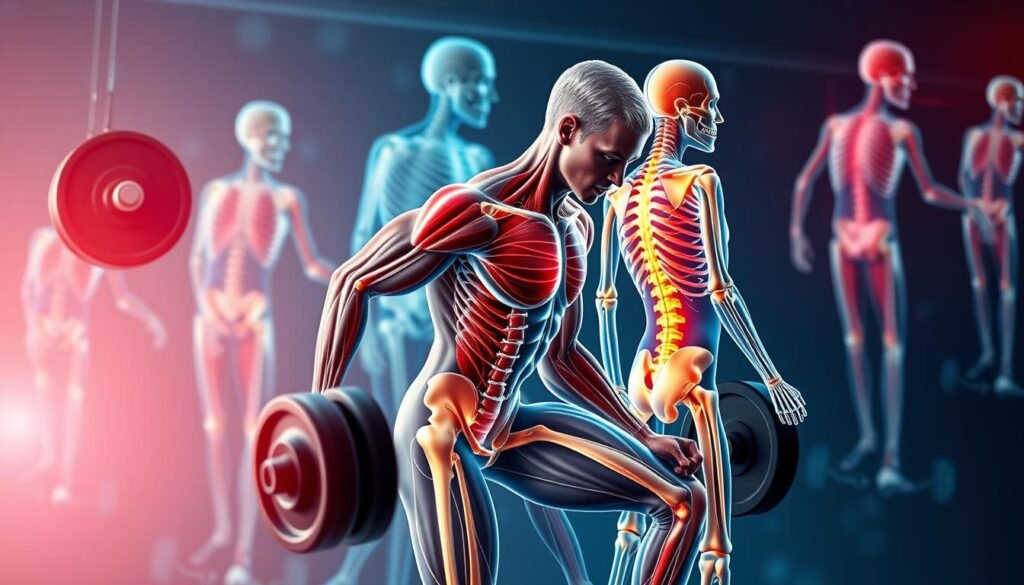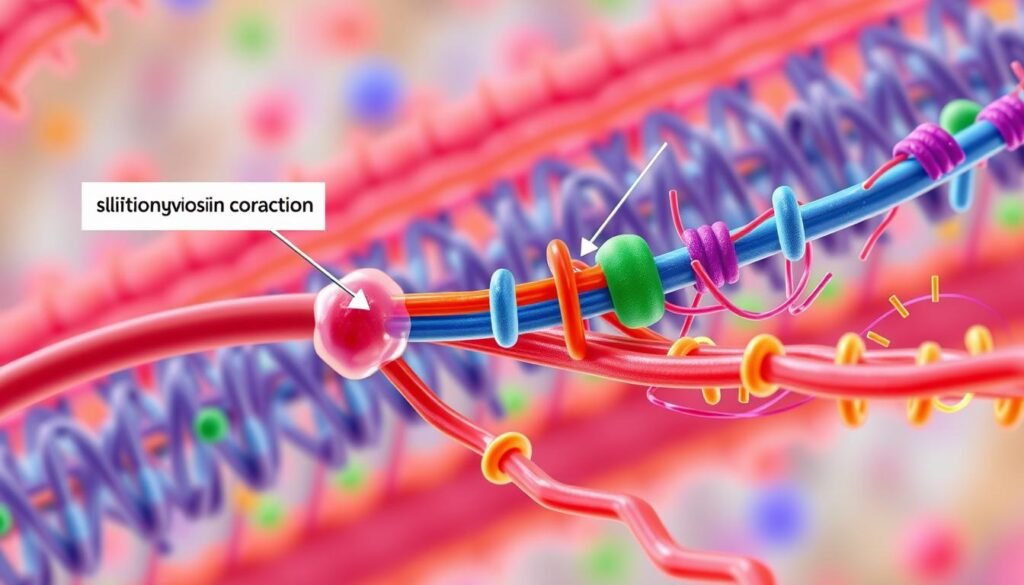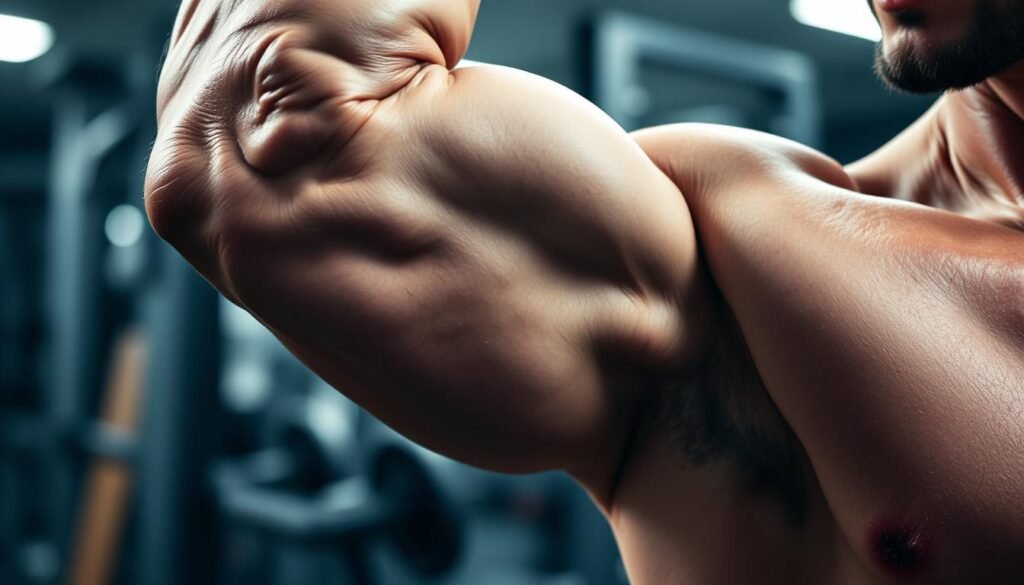Did you know the World Health Organization (WHO) says over 200 million people suffer from osteoporosis worldwide? This condition leads to weak bones and shows why we need ways to make bones stronger. With more people getting older, understanding how muscles work on bones is key.
Resistance exercise is a top way to keep and even up bone strength, helping our bodies stay fit. This article looks at how muscle contraction forces help bones stay dense and cut down fracture risks. We will see why adding resistance training to our workouts is important for fighting osteoporosis and sarcopenia.
Key Takeaways
- The prevalence of osteoporosis affects millions globally, making awareness and prevention critical.
- Muscle contractions significantly influence bone health via mechanical loading during exercise.
- Resistance exercise is crucial for maintaining or increasing bone mass and density.
- Incorporating various types of resistance training can effectively improve muscle strength and overall health.
- Regular strength training can lower the risk of fall-related fractures in older adults.
- Understanding the impact of muscle tension on bone microarchitecture is essential for effective fitness programming.
Introduction to Bone Strength and Muscle Contraction
Bone strength is key for staying healthy and moving freely, especially as we get older. Skeletal muscles connect to bones, giving our bodies structure and power. Learning how muscles work with bones can fight aging issues like osteosarcopenia. This is when both bone and muscle tissues weaken.
Muscle contractions help bones get denser through a process called mechanical loading. When muscles tighten, they pull on bones. This triggers bones to remodel and grow. That’s why lifting weights is important to keep bones strong as we age. In muscles, actin and myosin filaments work together to tighten. Their interaction is crucial for movement, which supports bone strength.
As we age, it’s vital to keep applying pressure on bones to stay healthy. Doing weight training can help avoid losing muscle and bone strength. This is key to preventing issues like osteosarcopenia. Studies suggest that resistance workouts keep muscles working well and bones strong. You can learn more about how muscles contract from this resource.
Understanding Muscle Contraction Forces
Muscle contraction is key for Bone Health. It helps by applying a Mechanical Load. We will look into what muscle contraction is and how it affects bone density.
Definition and Mechanism of Muscle Contraction
Muscle contraction makes muscles generate tension. This can happen even without the muscle getting shorter or longer. That means tension can be created in two ways. In one, muscles keep the same tension but change length.
When muscles get shorter, it’s called concentric contractions. If they lengthen, it’s eccentric contractions. Eccentric ones can cause more muscle damage but use less energy. This involves a complex interaction between muscle filaments, affecting muscle length and force.
How Muscle Forces Influence Bone Health
Muscles pulling on bones helps keep bones strong. This happens through something called osteoblastic activity. This is key for bone density. When muscles move, they put forces on the bones. This helps bones remodel themselves.
Constant pulling and pushing on bones helps them get stronger. Even short increases in muscle force, like from lifting weights, help bones. This makes bones stronger and more durable.
| Muscle Contraction Type | Description | Effect on Bone Health |
|---|---|---|
| Isometric | Maintains muscle length while generating tension. | Supports bone stability without significant movement. |
| Concentric | Muscle shortens as it contracts. | Enhances force transmission to bones, promoting growth. |
| Eccentric | Muscle lengthens as it contracts. | Increases mechanical load on bones, stimulates remodeling. |
The Importance of Resistance Exercise for Bone Density
Resistance exercise is key for promoting bone density and improving skeletal health. It is particularly important for older adults who are at risk for osteoporosis. By doing consistent resistance training, the body can build and keep strong bones. This helps decrease the risk of fractures over time.
What is Resistance Exercise?
Resistance exercise includes activities that make muscles work against an external force. This force can be from free weights, resistance bands, or body weight. Its main aim is to boost muscle strength, size, and endurance. This enhancement leads to better bone density. Resistance training can make bones bigger and stronger, showing it’s a good way to keep bones healthy.
Types of Resistance Exercises to Consider
There are many resistance exercises that can help increase bone density. Below is a table with different exercises:
| Type of Resistance Exercise | Examples |
|---|---|
| Isometric Exercises | Wall sits, plank variations |
| Isotonic Exercises | Deadlifts, squats, bench press |
| Isokinetic Exercises | Controlled speed exercises using specialized equipment |
Exercises like squats, lunges, and deadlifts can boost bone mineral density in key areas. It’s also crucial to work on balance to avoid falls, which can lead to fractures. Studies show that high-intensity resistance and impact training can improve bone density and muscle strength. By using these exercise methods carefully, people can maintain their bone health effectively.
Skeletal Muscle Mechanics and Its Role in Bone Strength
Skeletal Muscle Mechanics have a big impact on Bone Strength. They interact in ways that help us understand muscle contractions. These contractions help improve Bone Remodeling. Muscles make up about 40% of our body weight. They contain many proteins needed for movement and support. When muscles contract, the force goes through tendons to bones. This affects the bones’ strength and shape.
Overview of Skeletal Muscle Mechanics
Skeletal muscle fibers are cells covered by a membrane known as the sarcolemma. Inside these fibers are proteins like actin and myosin. These proteins are organized in units called sarcomeres. Muscle contractions are of two types: isometric, keeping muscle length the same, and isotonic, changing muscle length while applying force. Isotonic contractions split into two more types. Concentric contractions shorten the muscle. Eccentric contractions lengthen it.
Connection Between Muscle Mechanics and Bone Remodeling
Bone Remodeling is greatly affected by muscle contractions. Different types of muscle fibers contribute in unique ways. Type I fibers are for endurance. Type IIa and IIb fibers help with moderate and high-intensity efforts, respectively. Muscle contractions load the bone, starting a remodeling process. This process boosts bone density and strength. Forces from muscles reach bones through tendons. This keeps and improves Bone Strength.
| Muscle Fiber Type | Characteristics | Suitability |
|---|---|---|
| Type I (Slow Oxidative) | Low rate of fatigue | Endurance contractions |
| Type IIa (Fast Oxidative) | Moderate fatigue | Medium-duration activities |
| Type IIb (Fast Glycolytic) | High fatigue | Short-duration, intense movements |
It’s key to understand Skeletal Muscle Mechanics for Bone Strength. They make sure Bone Remodeling happens well through exercise and activity.
Effects of Muscle Tension on Bone Quality
Muscle tension is key in bone quality. It helps in keeping bones strong and can prevent osteoporosis.
How Muscle Tension Affects Bone Microarchitecture
Muscle tension and bone microarchitecture are closely linked. More muscle tension means more force on bones. This helps bones stay strong and healthy. Muscles pulling on bones encourages bone growth in those areas. This supports bone strength and integrity.
The Role of Muscle Tension in Osteogenesis
Osteogenesis, or bone formation, depends on muscle tension. This tension helps osteoblasts build bone. Less muscle use can weaken bones. But, muscle tension sends signals that boost bone building. This keeps bones dense and well-shaped. It’s crucial for fighting diseases linked to weak muscles or aging.
| Condition | Effect on Muscle Tension | Impact on Bone Quality |
|---|---|---|
| Healthy Muscle Activity | Increased tension during resistance training | Enhanced osteogenesis and improved microarchitecture |
| Muscle Paralysis (e.g., Botox) | Significant reduction in muscle tension | Increased bone resorption and reduced trabecular connectivity |
| Weightlessness (e.g., Tail Suspension) | Absence of muscle tension | Rapid loss of bone mass, particularly in trabecular regions |
| Resistance Exercise | Consistent muscle tension application | Promotion of bone density and significant strength improvements |
The Biomechanics of Movement and Bone Adaptation
The study of movement’s biomechanics is key to understanding how resistance training helps bones adapt. When people do resistance exercises, the muscle forces positively impact bone health. These forces influence how bones grow stronger, improving their density and overall toughness.
Understanding Biomechanics in Resistance Training
Biomechanics is about the mechanical laws that affect living beings’ movements. It looks into how body parts work together during activities, aiding in crafting successful resistance training plans. Specifically, resistance training involves moving in different ways that work out various muscles. For example:
- Sagittal Plane: Movements such as squats and deadlifts.
- Frontal Plane: Lateral lunges and side steps.
- Transverse Plane: Rotational exercises like Russian twists.
Studying these movements closely helps trainers improve how people move. This is vital for encouraging healthy bone changes.
Adaptive Responses in Bone Structures
Resistance training is crucial for bone adaptation. When muscles contract during workouts, they push forces onto the bones. This makes the bones stronger. Several factors play a part in this strengthening process:
Studies show resistance exercises greatly increase bone density, particularly in the most stressed areas.
This strengthening helps lower the risk of work-related bone and muscle issues. It highlights the need for progressively harder workouts and well-planned training routines. We must also think about how vibrations and other stresses affect bone health.

| Movement Type | Plane of Motion | Impact on Bone Health |
|---|---|---|
| Squats | Sagittal | Enhances quadriceps and femoral density |
| Lateral Lunges | Frontal | Improves hip bone density |
| Rotational Chest Pass | Transverse | Increases stability and strength |
Using biomechanics in resistance training leads to the best bone growth. It helps people stay healthy longer and reduces the chance of injuries.
Muscle Force Generation and Its Impact on Osteoporosis
Muscle strength is key to keeping bones dense and fighting osteoporosis. Knowing how muscle power and bone health are linked helps us find ways to lessen bone loss. This is crucial for people who are more likely to get osteoporosis.
Link between Muscle Force and Bone Density
There’s a clear link between muscle force and bone density. Sarcopenia, the loss of muscle mass and strength, leads to lower bone mineral density (BMD). This makes people, especially those over 65, more prone to osteoporosis. Studies show that men with less muscle mass have weaker bones. This shows how important muscles are for bone health.
Preventative Measures Against Osteoporosis
It’s vital to fight osteoporosis before it starts to keep bones healthy. Strength training programs increase muscle power, which boosts bone density. This reduces the risk of osteoporosis. Here are some recommended steps:
- Regular Resistance Training: Strength training two to three times a week makes muscles work. This is crucial for bone growth.
- Calcium and Vitamin D Intake: Getting enough calcium (1,200 mg for those over 70) and vitamin D (800 IU) is key for bone health.
- Balanced Nutrition: Eating foods rich in protein, fruits, and vegetables helps keep muscles and bones strong.
- Regular Health Screenings: Checking bone health can spot osteoporosis early on.
By improving muscle strength through exercise and eating right, you can help prevent osteoporosis. This makes you healthier overall.
| Preventative Measure | Description | Frequency |
|---|---|---|
| Resistance Training | Strength training exercises that enhance muscle force generation. | 2-3 times per week |
| Calcium Intake | Essential mineral for bone strength. | 1,200 mg daily for those over 70 |
| Vitamin D Intake | Supports calcium absorption and bone health. | 800 IU daily for those over 70 |
| Balanced Nutrition | Consuming a diet rich in nutrients that support muscle and bone health. | Daily |
| Health Screenings | Regular checks for early detection of bone health issues. | Annually or as recommended |
Actomyosin Interactions: The Basis of Muscle Contractions
Understanding how actin and myosin work together is key to knowing how muscles contract and get strong. These actomyosin interactions are the main way muscle cells contract. This leads to movements we need for many body functions. These actions are crucial not only for voluntary moves but also for keeping our bones healthy.
Detailed Mechanism of Actomyosin Interaction
Muscle contraction is a well-organized process at the cell level. It follows the sliding filament model. This shows how muscle fibers contract. They do this by letting actin and myosin filaments slide by each other in sarcomeres. Each sarcomere is a contractile unit with parts like the A band and I band, making skeletal muscles look striated.
In this process, myosin II hooks up with actin filaments. Myosin has a head that binds to actin. It uses energy from ATP to change shape. This lets it move along actin, causing muscles to contract effectively.
How Actomyosin Dynamics Influence Muscle Strength
The way actomyosin works together impacts muscle strength and function. Resistance training makes these interactions better, leading to stronger force. Stronger muscle contractions come from better cross-bridge actions between actin and myosin. This is essential for top muscle performance. It not only improves physical skills but also strengthens bones. Muscle contractions help bone remodeling, leading to stronger bones.

Excitation-Contraction Coupling and Bone Health
Understanding how excitation-contraction coupling works is key to knowing its role in muscle and bone health. It helps turn nerve signals into muscle movements. Good muscle action means stronger bones.
The Process of Excitation-Contraction Coupling
The process starts with action potentials that move along muscle fibers. This opens calcium channels due to the voltage changes. Calcium then enters muscle cells, leading to contraction.
Even small changes in the membrane’s potential can have big effects on the muscle’s power. This is crucial for understanding issues like muscle weakness and fatigue.
Impact on Muscle Activation and Bone Strength
How well this coupling works affects muscle strength and bone health. Active muscles put pressure on bones, which helps keep them strong. Balanced potassium levels are also necessary for muscle force.
Too much potassium, however, can weaken muscle force. This happens because of issues in the coupling process, reducing calcium flow in cells. It shows how vital the right coupling action is for our muscles and bones.
| Condition | Effect on Force Generation | Relevance to Bone Health |
|---|---|---|
| Normal Resting Potential | Stable muscle force | Supports healthy muscle activation |
| Mild Depolarization | Stable or slightly increased force | Enhances loading on bones |
| Severe Depolarization | Steep decline in force generation | Potentially detrimental to bone density |
| High Extracellular K+ | Initial increase, rapid decline | Impairs bone health through reduced muscle activity |
Overcoming Muscle Fatigue for Optimal Bone Strength
Muscle fatigue can greatly affect strength training. It’s especially true when building bone strength is the goal. Knowing how muscle fatigue works helps those focused on getting the most from resistance training. Managing fatigue is key for muscle recovery and bone health.
Understanding Muscle Fatigue’s Effects on Strength Training
Muscle fatigue makes it hard for muscles to contract after long periods of activity. This can hurt strength training. Energy loss, calcium signaling problems, and poor blood flow all cause muscle fatigue. It can slow down exercise progress. Knowing how muscle fatigue influences resistance workouts is crucial for boosting bone strength. If muscle fatigue lasts more than two weeks, see a doctor.
Strategies to Minimize Muscle Fatigue During Workouts
To build stronger bones, follow these tips to reduce muscle fatigue during workouts:
- Proper Warm-Up: A good warm-up gets muscles ready for work.
- Gradual Progression: Slowly increasing exercise intensity prevents too much fatigue.
- Incorporating Recovery: Resting between sets helps avoid muscle fatigue and boosts performance.
- Hydration and Nutrition: Drinking enough water and eating right keep energy up during workouts.
- Mindful Training: Paying attention to fatigue signs helps adjust workouts for better muscle use.
With these strategies, you can manage muscle fatigue and strengthen bones. Regular strength training and good fatigue control support muscle health and overall well-being. For more tips, check out this article on muscle fatigue. Also, knowing how to prevent injuries is key for muscle and bone health. Find more information in this article on musculoskeletal health.

Conclusion
This article showed how muscles work and help keep bones strong. Resistance training is key for bone health, especially as people get older. Understanding how muscles tighten and stretch shows how important they are for bones.
Adding resistance workouts to daily life is not only about getting stronger muscles. It’s also a way to fight bone and muscle weakness that comes with age. Studies show that muscles help shape and strengthen bones. This is vital for staying healthy as we age. Doing these workouts often can improve health and life quality for everyone.
In summary, resistance exercises are crucial for strong bones. They can help avoid the decrease in bone strength that comes with getting older. By doing these workouts, you invest in a healthier future. It’s about more than fitness; it’s caring for your health as you age.